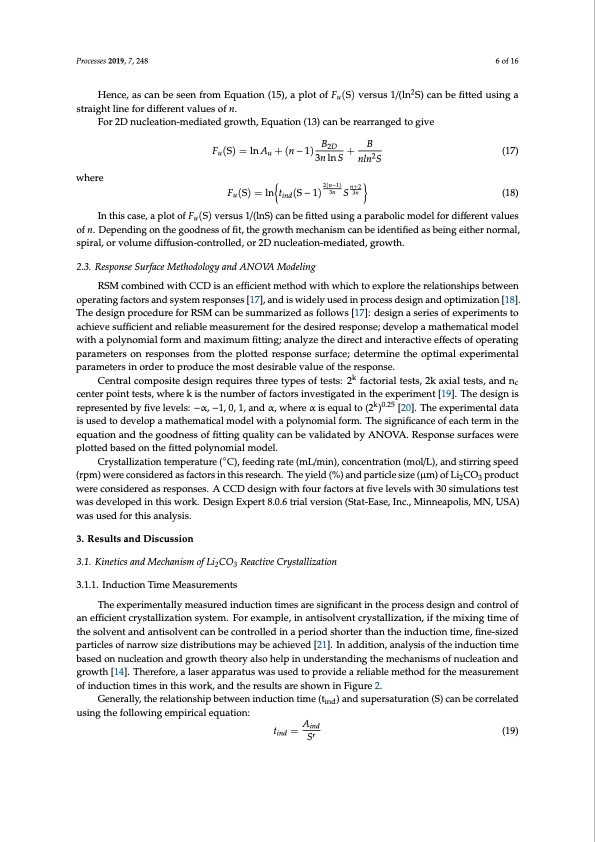
PDF Publication Title:
Text from PDF Page: 006
Processes 2019, 7, 248 6 of 16 Hence, as can be seen from Equation (15), a plot of Fu(S) versus 1/(ln2S) can be fitted using a straight line for different values of n. For 2D nucleation-mediated growth, Equation (13) can be rearranged to give Fu(S)=lnAu+(n−1) B2D + B (17) where 3n ln S nln2S 2(n−1) n+2 Fu(S)=lntind(S−1) 3n S3n (18) In this case, a plot of Fu(S) versus 1/(lnS) can be fitted using a parabolic model for different values of n. Depending on the goodness of fit, the growth mechanism can be identified as being either normal, spiral, or volume diffusion-controlled, or 2D nucleation-mediated, growth. 2.3. Response Surface Methodology and ANOVA Modeling RSM combined with CCD is an efficient method with which to explore the relationships between operating factors and system responses [17], and is widely used in process design and optimization [18]. The design procedure for RSM can be summarized as follows [17]: design a series of experiments to achieve sufficient and reliable measurement for the desired response; develop a mathematical model with a polynomial form and maximum fitting; analyze the direct and interactive effects of operating parameters on responses from the plotted response surface; determine the optimal experimental parameters in order to produce the most desirable value of the response. Central composite design requires three types of tests: 2k factorial tests, 2k axial tests, and nc center point tests, where k is the number of factors investigated in the experiment [19]. The design is represented by five levels: −α, −1, 0, 1, and α, where α is equal to (2k)0.25 [20]. The experimental data is used to develop a mathematical model with a polynomial form. The significance of each term in the equation and the goodness of fitting quality can be validated by ANOVA. Response surfaces were plotted based on the fitted polynomial model. Crystallization temperature (◦C), feeding rate (mL/min), concentration (mol/L), and stirring speed (rpm) were considered as factors in this research. The yield (%) and particle size (μm) of Li2CO3 product were considered as responses. A CCD design with four factors at five levels with 30 simulations test was developed in this work. Design Expert 8.0.6 trial version (Stat-Ease, Inc., Minneapolis, MN, USA) was used for this analysis. 3. Results and Discussion 3.1. Kinetics and Mechanism of Li2CO3 Reactive Crystallization 3.1.1. Induction Time Measurements The experimentally measured induction times are significant in the process design and control of an efficient crystallization system. For example, in antisolvent crystallization, if the mixing time of the solvent and antisolvent can be controlled in a period shorter than the induction time, fine-sized particles of narrow size distributions may be achieved [21]. In addition, analysis of the induction time based on nucleation and growth theory also help in understanding the mechanisms of nucleation and growth [14]. Therefore, a laser apparatus was used to provide a reliable method for the measurement of induction times in this work, and the results are shown in Figure 2. Generally, the relationship between induction time (tind) and supersaturation (S) can be correlated using the following empirical equation: tind = Aind (19) SrPDF Image | Reactive Crystallization Process of Lithium Carbonate

PDF Search Title:
Reactive Crystallization Process of Lithium CarbonateOriginal File Name Searched:
processes-07-00248-v2.pdfDIY PDF Search: Google It | Yahoo | Bing
Product and Development Focus for Infinity Turbine
ORC Waste Heat Turbine and ORC System Build Plans: All turbine plans are $10,000 each. This allows you to build a system and then consider licensing for production after you have completed and tested a unit.Redox Flow Battery Technology: With the advent of the new USA tax credits for producing and selling batteries ($35/kW) we are focussing on a simple flow battery using shipping containers as the modular electrolyte storage units with tax credits up to $140,000 per system. Our main focus is on the salt battery. This battery can be used for both thermal and electrical storage applications. We call it the Cogeneration Battery or Cogen Battery. One project is converting salt (brine) based water conditioners to simultaneously produce power. In addition, there are many opportunities to extract Lithium from brine (salt lakes, groundwater, and producer water).Salt water or brine are huge sources for lithium. Most of the worlds lithium is acquired from a brine source. It's even in seawater in a low concentration. Brine is also a byproduct of huge powerplants, which can now use that as an electrolyte and a huge flow battery (which allows storage at the source).We welcome any business and equipment inquiries, as well as licensing our turbines for manufacturing.| CONTACT TEL: 608-238-6001 Email: greg@infinityturbine.com | RSS | AMP |